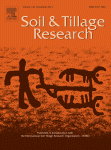Ver ítem
- xmlui.general.dspace_homeCentros Regionales y EEAsCentro Regional Buenos Aires NorteEEA General VillegasArtículos científicosxmlui.ArtifactBrowser.ItemViewer.trail
- Inicio
- Centros Regionales y EEAs
- Centro Regional Buenos Aires Norte
- EEA General Villegas
- Artículos científicos
- Ver ítem
Cover crop effects on soybean residue decomposition and P release in no-tillage systems of Argentina
Resumen
Cover crops (CC) provide many benefits to soils but their effect on decomposition of previous crop residues and release of nutrients in continuous no-tillage soybean [Glycine max (L.) Merr.] production are little known. Our objective was to quantify CC effects on decomposition and phosphorus (P) release from soybean residue using litterbags. Three CC species (oat, Avena sativa L.; rye, Secale cereal L.; and rye grass, Lolium multiflorum L.) and a no CC
[ver mas...]
Cover crops (CC) provide many benefits to soils but their effect on decomposition of previous crop residues and release of nutrients in continuous no-tillage soybean [Glycine max (L.) Merr.] production are little known. Our objective was to quantify CC effects on decomposition and phosphorus (P) release from soybean residue using litterbags. Three CC species (oat, Avena sativa L.; rye, Secale cereal L.; and rye grass, Lolium multiflorum L.) and a no CC control were evaluated. Temperature, moisture content, microbial biomass and microbial activity were measured in the surface 2 cm of soil and residues. Cover crops increased soybean residue decomposition slightly both years (8.2 and 6.4%). Phosphorus release from soybean residue did not show any significant differences. Cover crops increased microbial biomass quantity and activity in both soil and residue samples (p < 0.001, p = 0.049 for soil and residue microbial biomass; p = 0.060, p = 0.003 for soil and residue microbial activity, respectively). Increased residue decomposition with CC was associated with higher soil and residue microbial biomass and activity, higher near-surface (0–2 cm) moisture content (due to shading) and soil organic carbon enrichment by CC. Even though CC increased soybean residue decomposition (233 kg ha−1), this effect was compensated for by the annual addition of approximately 6500 kg ha−1 of CC biomass. This study demonstrated another role for CC when calibrating models that simulate the decomposition of residues in no-tillage systems.
[Cerrar]

Autor
Varela, María Florencia;
Scianca, Carlos Maria;
Taboada, Miguel Angel;
Rubio, Gerardo;
Fuente
Soil and Tillage Research 143 : 59-66 (November 2014)
Fecha
2014-11
ISSN
0167-1987
Formato
pdf
Tipo de documento
artículo
Palabras Claves
Derechos de acceso
Restringido
 Excepto donde se diga explicitamente, este item se publica bajo la siguiente descripción: Creative Commons Attribution-NonCommercial-ShareAlike 2.5 Unported (CC BY-NC-SA 2.5)
Excepto donde se diga explicitamente, este item se publica bajo la siguiente descripción: Creative Commons Attribution-NonCommercial-ShareAlike 2.5 Unported (CC BY-NC-SA 2.5)

